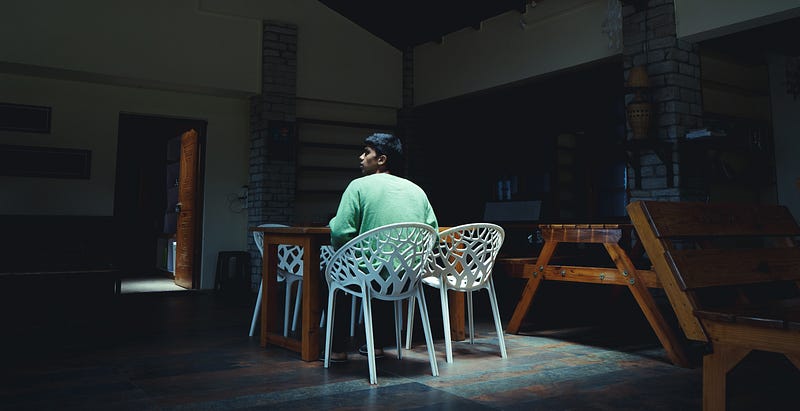Why Eye-Trace is Vital for Good Prose
activating a reader’s imagination by directing their inner eye

Activating a reader’s imagination by directing their inner eye
In cinematography, eye-trace is a technique for directing the viewer's gaze to specific areas of the image across consecutive shots. It’s about understanding how to keep the audience’s gaze coherent from shot to shot, how to subtly direct the points on which they focus — without their even realizing it’s happening. Eye-tracing is one of the fundamental aspects of good filmmaking, but it’s also a vital component of “layered text” when writing prose.
In cinematography, eye-trace is vital because it keeps the viewer’s eyes from darting all over the screen from cut to cut. In long, slow cuts, this might not matter as much from a technical standpoint (as the viewer will at least have time to adjust their gaze) but if multiple cuts happen in quick succession, it can become immensely jarring.
Writers don’t have the same problem to worry about — a reader can spend as long as they want on any sentence or paragraph and decipher things they might have missed on their own time. But it’s not the reader’s physical eyes that a writer needs to concentrate on, but rather the reader’s “inner eye,” their imagination.
Again, eye-tracing is not about simply knowing where the viewer is looking, it’s about directing that gaze. Remember the old Chekhov quote about the gun on the mantelpiece? If it shows up in Act One it needs to be used by Act Three. Note how a writer might direct the reader’s attention toward a gun on a mantelpiece, how it might be overtly or subtly signaled as an item of importance.
Directing the reader’s inner mind to specifics of place is incredibly important when writing prose, especially in moments of high action. The best-fight scenes, for instance, are written in such a way that the reader’s mind fluidly follows the central action — once the action starts, the writer doesn’t want to let the reader’s attention wander.
A fight scene where the eye-trace jumps between six different points of action will be muddled and confused, whereas a scene where the primary actor remains in focus throughout will be easier for the reader to envision. In this way, it’s about not making the reader work too hard to visualize an event after it has begun. Some time might be used to set up a scene, to create the space and the characters within it, but once a moment of intense action begins the reader should not have to stop and re-visualize things because that interrupts the flow.
Exercising the example
Observe how the eye-trace in this paragraph moves:
James swings and cracks the policeman on the jaw and the man falls, but already two more of the “boys in blue” are charging in. Overhead the helicopter’s blades echo off the skyscrapers like drums in an empty canyon. James kicks the man on the ground for good measure, but a shot from one of the approaching police brings him up short.
Notice how jarring it is, how much more work the reader has to do to keep up with what’s occurring?
The eye trace goes like this:
- James
- Policeman
- Jaw
- Policeman falls
- Two more policemen running
- Helicopter blades
- Skyscrapers
- Canyon
- James kicks
- Man on ground
- Shot
- Police
- James
As an exercise, could you take all those same elements and rearrange them (without extending the paragraph to too great a degree) into something that has better eye-trace?
Here’s mine:
Helicopter blades whir, they fill the space between the skyscrapers like drums in a canyon. James’s uppercut cracks the policeman’s jaw and the man drops to the ground. But James isn’t done. He goes in for a kick, ready to slam his prone opponent with the hard toe of his boot, but the loud crack of a service revolver startles him. Bullets smack into the pavement as James dives for cover behind a parked car. He winces as one of the tires explodes from the impact of a round.
Now we have a flow like this:
Helicopter blades, skyscrapers, canyon image (but clearly as a metaphor). James in motion, uppercut strikes, policeman’s jaw, policeman falls. James kicks (though James as a whole comes back into focus, the kick is highlighted, and is a visually-low event, suggesting continuity with the earlier act of falling).
Then the eye trace pulls back with the loud crack — but it’s connected to a service revolver, which suggests more police. Bullets strike pavement (another low space, keeping in continual focus with the earlier close to ground perspective, and also following through from the sound of the gun. James dives for cover (still low), and then the result of the bullets is seen again as a car tire (low) explodes.

Juxtaposition
Obviously, action scenes are a great place to begin exploring how eye-trace in prose functions, but they are not the only area where it matters.
In cinematography, the juxtaposition of images creates specific associations for the viewer. The same is true for static words on the page. Mystery writers know this and use it to their advantage, often hiding clues to the larger mystery within a pattern of signifiers: The position of people in a room, the open window, the fact that one person stands near a piano, the fact that another is sipping a drink, the sound of a distant gunshot heard at the same time as the person with the drink drops their glass.
However, the same thing is true for the characters themselves. A good writer will understand that to make their characters truly inhabit the space that the writer has created for them, they need to have the appearance of interior lives. One of the best ways to show this is through what a character notices (or does not notice). In this way, the writer is working with two different eye-traces — the imagination of the reader but also the actual experience of the POV character.
What a character observes about the things around them acts as a signifier of who they are, it suggests personality, temperament, urgency, physical ability, culture, social status, gender, and training. Sometimes a character’s perception is specifically emphasized in some way in order to draw attention to a completely different aspect of the story — another character, for instance.
A somewhat obvious example is the difference highlighted between Dr. Watson and Sherlock Holmes with regards to the number of stairs in B-21 Baker Street. Watson walks up and down those stairs every day and never pays them any mind, but of course, Holmes knows their exact number (and probably the color and location of the stains on carpeting as well). While this example is over-emphasized for an effect, it showcases the importance of what a character perceives in the creation of their identity for the reader.
In Agatha Christie’s mysteries, Mrs. Marple is frequently overlooked by the people she’s observing. Why? Because she’s a frumpy old lady and nobody pays attention to little old ladies. But more than just being a point of humor, this highlights something about who Mrs. Marple is — how shrewd she, as a character is, and how generally unobservant most of the people she encounters actually are. Or, in the case of some of the police officers with whom she occasionally works, a grudging (and sometimes overt) respect is highlighted on their part because they — being trained to observe — end up realizing just how astute and deliberate Mrs. Marple really is. Likewise, the reader is not merely given a mystery, they’re given a specific way of looking at the world through which they must experience the mystery.

When working with prose, a writer needs to select what is shown with some degree of care. They cannot spend ten pages describing, in minute detail, the furniture of a room and expect the reader to remain interested the entire time — even if it’s a story about antiques.
The writer needs to play with words as a cinematographer plays with light; splashes of vivid description are highlighted by the shadow that surrounds them. These splashes set the scene. Then it is time for the characters to enter, and through their observations, more of the space come alive.
The things that stand out, the glaring absences, the subtle and the overt, all merge into a total experience of space, time, action, and motivation for the reader. Through this process, the world is formed, and the reader’s imagination is given the direction it needs to build the whole narrative experience from nothing more than black symbols on a white page.
